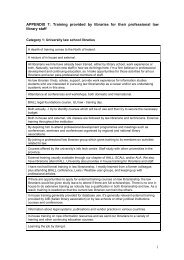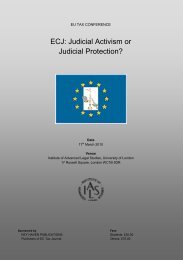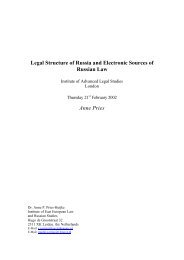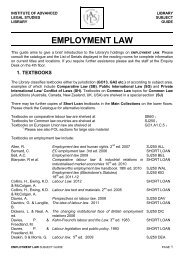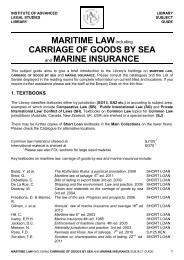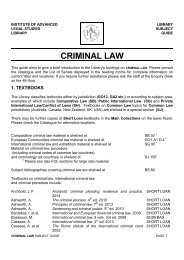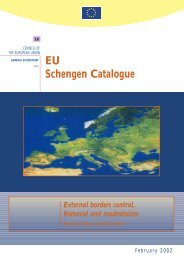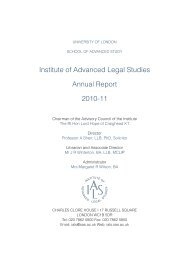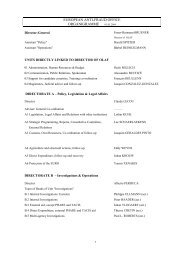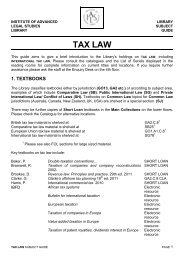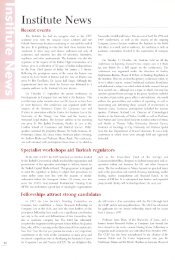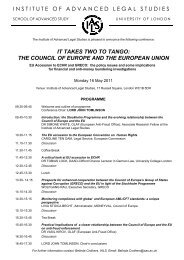a thesis - Institute of Advanced Legal Studies
a thesis - Institute of Advanced Legal Studies
a thesis - Institute of Advanced Legal Studies
Create successful ePaper yourself
Turn your PDF publications into a flip-book with our unique Google optimized e-Paper software.
CONSTRUCTION OF EXPRESS TRUSTS. 67<br />
remainders, remainder to the use <strong>of</strong> the heirs male <strong>of</strong> the body <strong>of</strong><br />
B. and their heirs. This is a trust [executed], and B. takes an<br />
estate tail [male]. WrigM v. Pearson (1758), 1 Eden, 119.<br />
3. A. devises land to trustees in trust to pay certain annuities,<br />
and subject thereto in trust for B. and his assigns for life, without<br />
impeachment <strong>of</strong> waste, remainder to the trustees to preserve contingent<br />
remainders, remainder to the use <strong>of</strong> the heirs <strong>of</strong> the body<br />
<strong>of</strong> B., remainder to testator's own right heirs. He then gives the<br />
residue <strong>of</strong> his personal estate to be laid out in land, which shall<br />
thereafter remain, continue, and be to the like uses, B. takes an<br />
estate tail in the land to be purchased. Austen v. Taylor (1759),<br />
1 Eden, 361.<br />
It should be mentioned here that although technical words <strong>of</strong><br />
limitation have the same construction in executed trusts as in legal<br />
limitations, where no technical words <strong>of</strong> limitation are used at all,<br />
trusts, executed as well as executory, are sometimes construed<br />
more liberally. The authorities are somewhat confusing, and<br />
there appears to be some conflict between the older text-book<br />
writers and the more modern. The subject is dealt with in<br />
Cruise's Digest, vol. i. 343 (which seems to give the rule too<br />
favourably to trusts) ; Hayes, Conveyancing, 5th ed. vol. i. 91;<br />
Preston, Estates, vol. ii. 64; Williams, Real Property, 19th ed.<br />
181; Lewin, Trusts, 10th ed. 117, 118; and Elphinstone, Interpretation<br />
<strong>of</strong> Deeds, rule 104—which seems to give the rule too<br />
narrowly.<br />
Perhaps the rule may be stated to be that a limitation <strong>of</strong> a<br />
trust <strong>of</strong> real estate without words <strong>of</strong> inheritance will give the<br />
beneficiary a life estate only unless an intention on the part <strong>of</strong> the<br />
settlor or grantor to pass a fee simple or fee tail appears in the<br />
instrument containing the limitation.<br />
The cases <strong>of</strong> HolUday v. Overtoil (1852, 15 Beav. 480); Lucas<br />
v. Brandreth (1860, 28 Beav. 274); Tatham v. Vernon (1861, 29<br />
Beav. 604) ; Meyler v. Meyler (1883, 11 L. R. Ir. 532) ; In re<br />
Whiston's Settlement (1894, 1 Oh. 651) ; Dearlerg v. Letchford<br />
(1895, 72 L. T. 892); and In re Irwin (1904, 2 Ch. 753), are<br />
instances <strong>of</strong> the absence <strong>of</strong> any indication <strong>of</strong> such intention.<br />
The cases <strong>of</strong> Pugh v. Drew (1869, 17 W. R 988) ; In re<br />
Trinyham's Trusts (1904, 2 Ch. 487); and In re Oliver's Settlement<br />
(1904, 74 L. J. Ch. 62), are instances in which sufficient indication<br />
<strong>of</strong> an intention to pass the fee simple was found.<br />
r2



